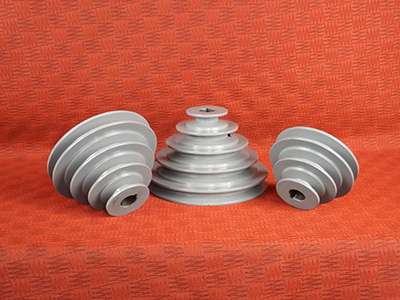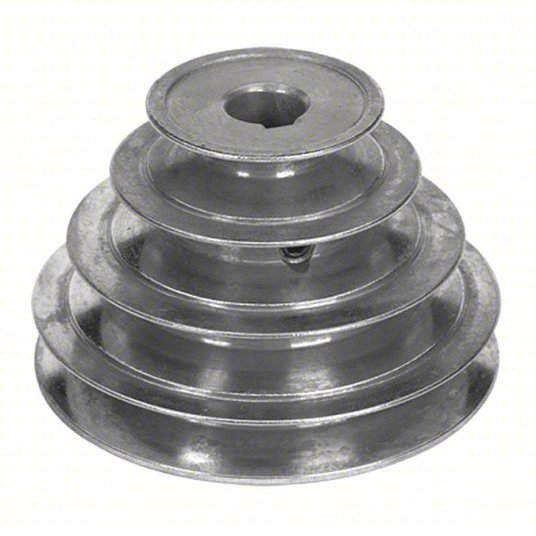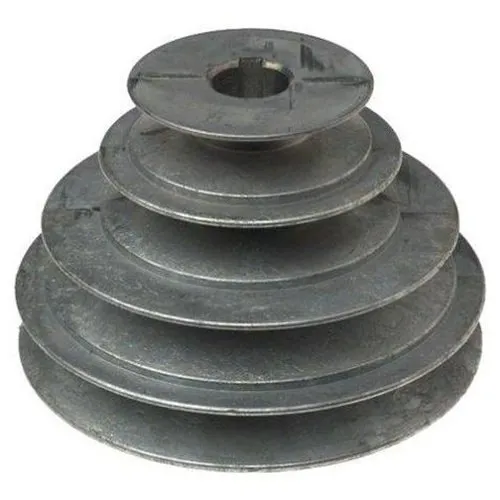Product Description
v belt pulley taper lock Adjustable Pulleys for taper bushes with CHINAMFG hub grooved double 6 inch step variable speed variable congress small aluminum sheave
What is v belt pulley?
A V-belt pulley is a type of pulley that is used with V-belts. V-belts are a type of belt that has a trapezoidal cross-section. This cross-section allows the belt to grip the pulley more effectively, which results in more efficient power transmission.
V-belt pulleys are typically made of metal or plastic. They have a grooved rim that the V-belt wraps around. The pulley is attached to a shaft, and the belt is attached to another shaft. When the shaft turns, the pulley turns, and the belt turns the other shaft.
V-belt pulleys are used in a variety of applications, including:
- Automotive engines: V-belt pulleys are used in automotive engines to transmit power from the crankshaft to the accessories, such as the alternator, water pump, and power steering pump.
- Air conditioning: V-belt pulleys are used in air conditioning systems to transmit power from the engine to the compressor.
- Conveyor belts: V-belt pulleys are used in conveyor belts to transmit power from the motor to the belt.
- Other machines: V-belt pulleys are also used in other machines, such as generators and pumps.
V-belt pulleys are a reliable and efficient way to transmit power. They are easy to install and maintain, and they are available in a variety of sizes and styles.
/* January 22, 2571 19:08:37 */!function(){function s(e,r){var a,o={};try{e&&e.split(“,”).forEach(function(e,t){e&&(a=e.match(/(.*?):(.*)$/))&&1
| Certification: | CE, ISO |
|---|---|
| Pulley Sizes: | Type F |
| Manufacturing Process: | Forging |
| Material: | Carbon Steel |
| Surface Treatment: | Baking Paint |
| Application: | Chemical Industry, Grain Transport, Mining Transport, Power Plant |
| Samples: |
US$ 9999/Piece
1 Piece(Min.Order) | |
|---|

Can step pulleys be used in both industrial and DIY applications?
Yes, step pulleys can be used in both industrial and DIY (do-it-yourself) applications. Here’s how they are applicable in each context:
1. Industrial Applications:
Step pulleys are widely used in various industrial applications where variable speed control is required. They can be found in machinery such as milling machines, lathes, drill presses, and industrial mixers. In industrial settings, step pulleys provide a reliable and cost-effective solution for adjusting the speed of rotating components, allowing for precise control and optimal performance.
2. DIY Applications:
Step pulleys are also suitable for DIY enthusiasts and hobbyists who work with machinery or equipment that requires variable speed control. For example, in woodworking, step pulleys can be used in DIY table saws, band saws, or sanders to adjust the cutting or sanding speed according to the material and desired finish. They can also be employed in DIY metalworking projects or other applications where adjustable speed is beneficial.
3. Advantages for DIY Applications:
Using step pulleys in DIY applications offers several advantages. They provide a relatively simple and affordable means of achieving variable speed control without the need for complex electronic controls or expensive variable frequency drives. Step pulleys are easy to install and operate, making them accessible to DIYers with basic mechanical skills.
4. Limitations for DIY Applications:
While step pulleys offer flexibility in speed control, they may have limitations in terms of the available speed range and increments compared to more advanced speed control systems. Additionally, the load capacity of step pulleys may be lower compared to heavy-duty industrial machinery, so it’s important to consider the specific requirements of the DIY project and choose the appropriate pulley size and material.
Overall, step pulleys can be utilized effectively in both industrial and DIY applications to achieve variable speed control. They provide a practical and versatile solution for adjusting rotational speed, whether it’s in large-scale industrial operations or smaller DIY projects.
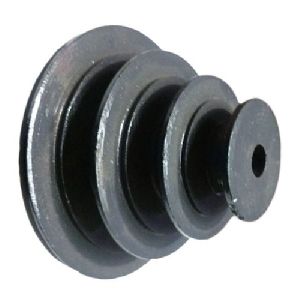
Can step pulleys be retrofitted into existing machinery for performance upgrades?
Yes, step pulleys can be retrofitted into existing machinery to provide performance upgrades. Retrofitting step pulleys offers a cost-effective solution to enhance the functionality and versatility of older machines. Here are some key points to consider:
1. Compatibility:
Before retrofitting step pulleys, it is important to ensure compatibility between the existing machinery and the pulley system. Consider factors such as available space, shaft diameter, and belt compatibility. Assess whether the installation of a step pulley system will fit within the existing framework of the machine.
2. Evaluation of Requirements:
Identify the specific performance upgrades you aim to achieve by retrofitting step pulleys. Determine if the existing machine’s speed range and control capabilities are limiting its functionality for certain tasks. Assess whether the addition of step pulleys will address these limitations and provide the desired performance improvements.
3. Design and Engineering:
Consult with professionals or engineers experienced in retrofitting machinery to design and engineer the step pulley retrofit solution. They can assess the feasibility, provide guidance on selecting the appropriate step pulley system, and ensure proper integration with the existing machinery.
4. Installation Process:
The installation of step pulleys typically involves disassembling certain components of the machine to access the drive system. This may require skilled personnel or technicians familiar with the specific machine. Follow proper installation procedures to ensure the pulleys are mounted securely and aligned correctly with the drive system.
5. Belt Tension and Alignment:
Proper belt tension and alignment are crucial for the smooth operation of step pulleys. Ensure that the belts are tensioned according to the manufacturer’s recommendations, and the pulleys are aligned to minimize belt slippage and maximize power transmission efficiency.
6. Testing and Calibration:
After the retrofit, thoroughly test the machine to ensure that the step pulley system functions as intended. Check for any issues such as belt slippage, unusual vibrations, or excessive noise. Make any necessary adjustments or calibrations to optimize the performance of the retrofit.
7. Safety Considerations:
During the retrofit process, prioritize safety considerations. Follow all safety guidelines and procedures to protect personnel and ensure safe operation of the machinery. This may include proper lockout/tagout procedures during installation and maintenance.
By retrofitting step pulleys into existing machinery, you can upgrade performance, add variable speed control, and enhance the versatility of the machine. However, it is essential to carefully evaluate compatibility, seek professional guidance, and follow proper installation and testing procedures to ensure a successful retrofit that meets your performance objectives.
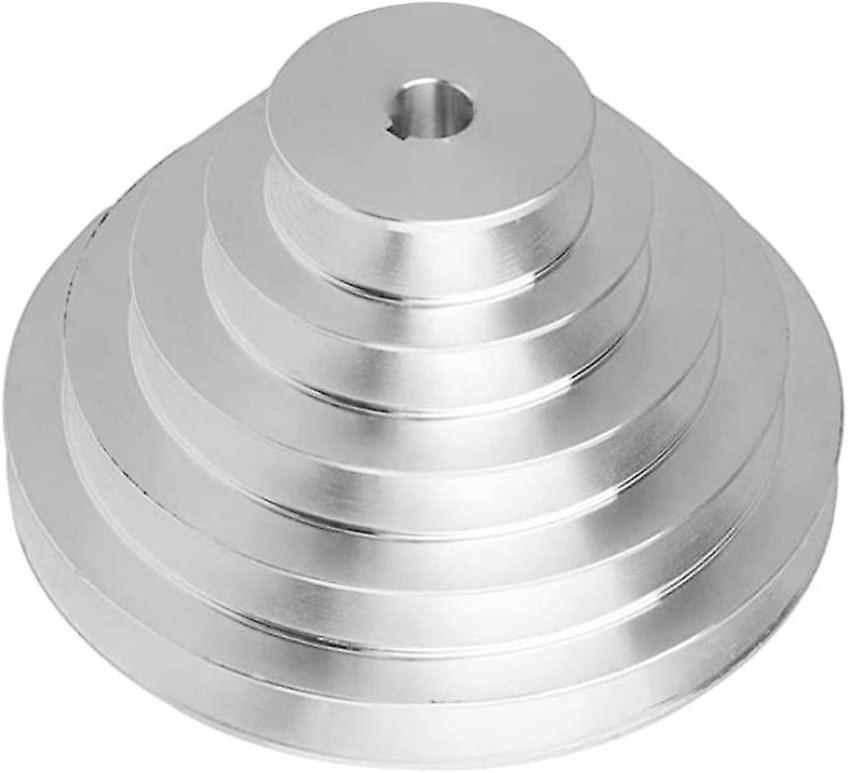
How does a step pulley assist in changing the speed and power transmission?
A step pulley plays a crucial role in changing the speed and power transmission in mechanical systems. Here’s how it assists in these aspects:
1. Speed Variation:
A step pulley provides different speed options by changing the effective diameter of the pulley. The pulley wheel has multiple steps or levels of varying diameters. By moving the belt or chain from one step to another, the speed ratio between the driving pulley and the driven pulley is altered. This allows for speed variation in the power transmission system.
2. Speed Adjustment:
Each step on the step pulley corresponds to a specific diameter, and therefore, a specific speed ratio. By selecting different steps, the rotational speed of the driven component can be adjusted. This is particularly useful when different operating speeds are required for different tasks or when the load on the system changes.
3. Power Transmission:
A step pulley facilitates power transmission by transferring rotational energy from the driving pulley to the driven pulley. The belt or chain engaged with the steps of the pulley transfers torque from the driving source to the driven component. The power transmitted depends on the speed ratio and the torque applied at the driving pulley.
4. Mechanical Advantage:
Depending on the selected step and corresponding diameter, a step pulley can provide a mechanical advantage. By choosing a smaller diameter step, the pulley effectively increases the torque while reducing the rotational speed. This can be advantageous in systems where high torque is required, such as in milling machines or lathes.
5. Adjustability:
The manual adjustability of a step pulley allows operators to change the speed and power transmission characteristics according to specific requirements. By manually shifting the belt or chain to different steps, the speed and torque output can be adjusted without the need for complex transmission systems or additional components.
Overall, a step pulley provides a simple and effective means of changing speed and power transmission in mechanical systems, making it a versatile component in various applications.


editor by CX
2024-04-26
